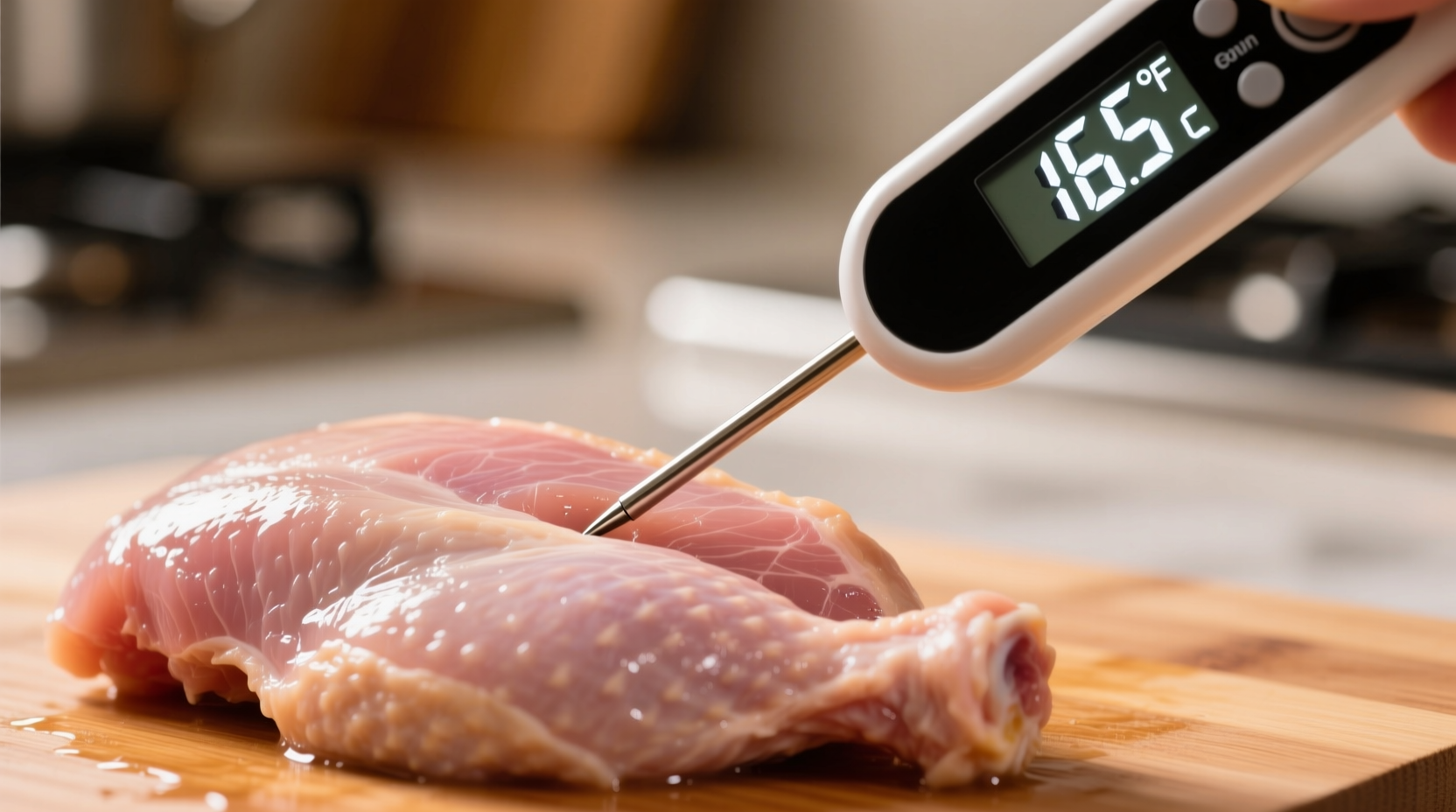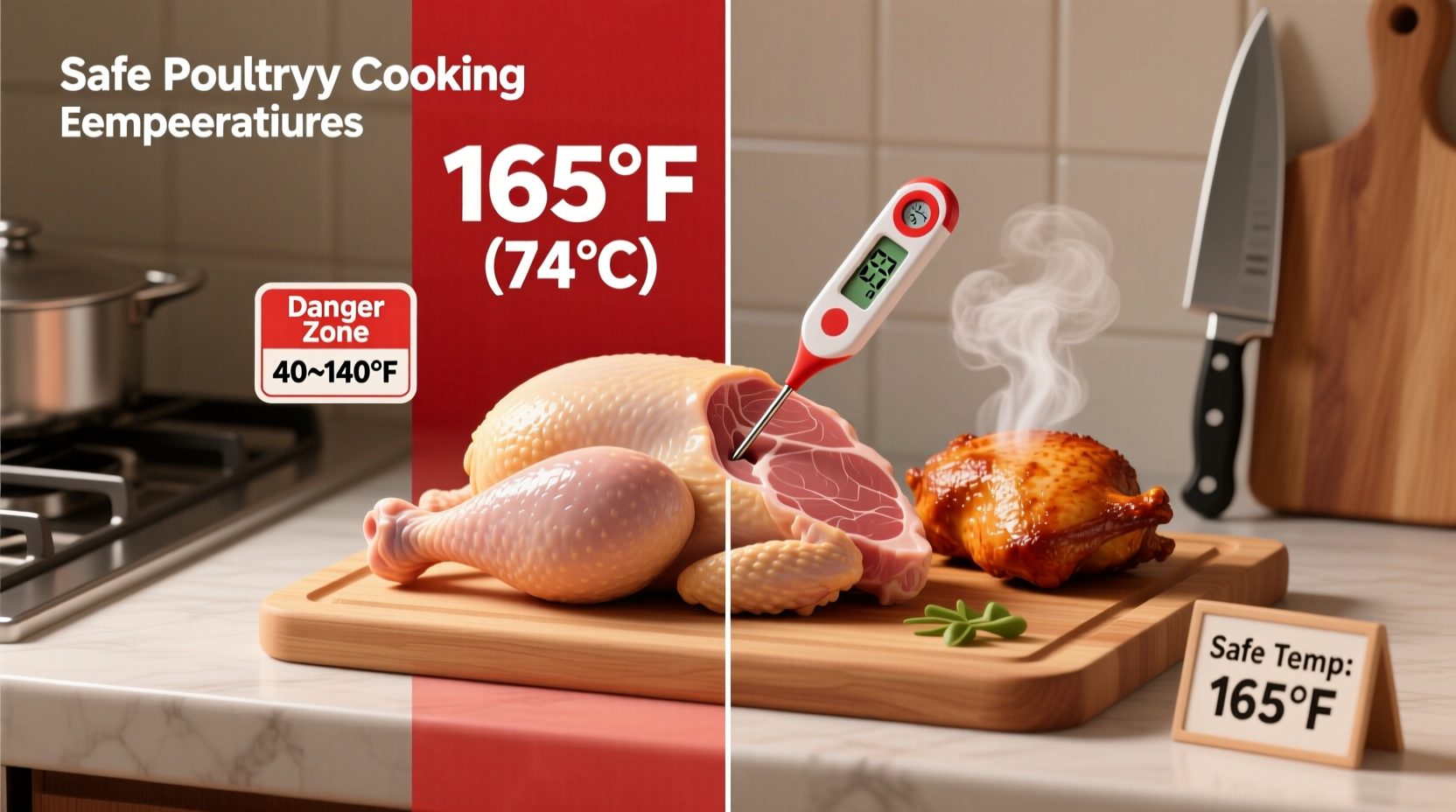Raw poultry must reach a minimum internal temperature of 165°F (73.9°C) to be safely consumed. This critical food safety standard, established by the USDA Food Safety and Inspection Service, destroys harmful bacteria like salmonella and campylobacter that cause foodborne illness.
When you're preparing chicken, turkey, or duck at home, getting the temperature right isn't just about doneness—it's your primary defense against food poisoning. Millions of Americans experience foodborne illnesses annually, with poultry being a leading culprit. Understanding and implementing proper cooking temperatures transforms your kitchen from a potential hazard zone into a safe food preparation environment.
Why 165°F Is Non-Negotiable for Poultry Safety
Unlike beef or pork, poultry requires complete pathogen elimination because harmful bacteria penetrate deep into the muscle tissue during processing. The USDA's 165°F standard isn't arbitrary—it represents the temperature at which salmonella bacteria die within seconds. Lower temperatures leave dangerous pathogens alive, potentially causing severe gastrointestinal illness.
"Many home cooks rely on visual cues like clear juices or firm texture," explains Antonio Rodriguez, culinary safety expert. "These methods are dangerously unreliable. Only a properly calibrated thermometer provides certainty that your poultry has reached safe temperatures."
The Evolution of Poultry Safety Standards
Poultry cooking recommendations have evolved significantly as food science advanced:
- 1970s-1990s: Recommendations focused on visual doneness indicators with no standardized temperature
- 1995: USDA introduced 180°F for whole birds, 170°F for parts—temperatures later found unnecessarily high
- 2006: Research demonstrated 165°F effectively kills pathogens while preserving moisture
- 2011: USDA officially adopted 165°F as the universal standard for all poultry products
Essential Tools for Accurate Temperature Measurement
Not all thermometers deliver reliable readings. For poultry safety, you need:
- Digital instant-read thermometers: Provide accurate readings in 2-5 seconds
- Proper calibration: Test monthly using ice water (32°F) or boiling water (212°F)
- Correct placement: Insert into thickest part without touching bone

Poultry Temperature Reference Guide
| Poultry Type | Minimum Safe Temperature | Critical Measurement Zones |
|---|---|---|
| Whole chicken/turkey | 165°F (73.9°C) | Innermost part of thigh, wing, and thickest breast area |
| Boneless breasts/thighs | 165°F (73.9°C) | Center of thickest portion |
| Ground poultry | 165°F (73.9°C) | Middle of patty or meatball |
| Stuffed poultry | 165°F (73.9°C) | Center of stuffing AND meat |
Avoiding Common Temperature Mistakes
Even experienced cooks make critical errors when checking poultry temperatures:
- The bone test: Inserting thermometer near bone gives falsely high readings
- Single-point checking: Testing only one location misses cold spots
- Resting period errors: Removing from heat too early prevents residual cooking
- Cross-contamination: Using same thermometer for raw and cooked without cleaning
Professional kitchens implement a three-point verification system: checking multiple locations in each piece and confirming with a secondary thermometer. At home, check at least two locations in larger pieces and allow 3-5 minutes of resting time after removal from heat.
Special Considerations for Different Cooking Methods
While the 165°F standard remains constant, your approach varies by cooking technique:
- Sous vide: Requires precise time-temperature combinations (e.g., 145°F for 30+ minutes)
- Smoking: Must still reach 165°F internally despite lower ambient temperatures
- Grilling: Check temperature before removing from heat—don't wait until plating
- Slow cooking: Verify final temperature even after all-day cooking
The FDA Food Code confirms that poultry safety depends solely on internal temperature, not cooking method. "Many believe smoking or slow cooking inherently makes poultry safe," notes Rodriguez. "Without verified 165°F internal temperature, these methods still risk foodborne illness."
When the Rules Have Exceptions
Certain specialized cooking techniques create context boundaries where traditional temperature rules don't apply:
- Commercial pressure cooking: Validated processes can use lower temperatures with extended times
- Certified sous vide systems: Precise time-temperature combinations can achieve equivalent safety at lower temps
- Industrial food production: HACCP plans may use different critical limits with verification protocols
For home cooks, however, 165°F remains the only universally safe standard. The USDA explicitly states: "There is no recommended lower temperature for safely preparing poultry at home."
Building Temperature Safety Into Your Cooking Routine
Make temperature verification part of your automatic cooking process:
- Place thermometer within easy reach before starting to cook
- Check temperature 5-10 minutes before expected doneness
- Verify multiple locations in each piece of poultry
- Clean thermometer with hot soapy water between checks
- Record temperatures for critical dishes until verification becomes habitual
Food safety experts recommend treating your thermometer with the same importance as your chef's knife. "Temperature verification isn't optional—it's the final, essential step in poultry preparation," emphasizes Rodriguez. "Skipping this step is like driving without a seatbelt: you might be fine today, but the risk accumulates with every meal."











 浙公网安备
33010002000092号
浙公网安备
33010002000092号 浙B2-20120091-4
浙B2-20120091-4